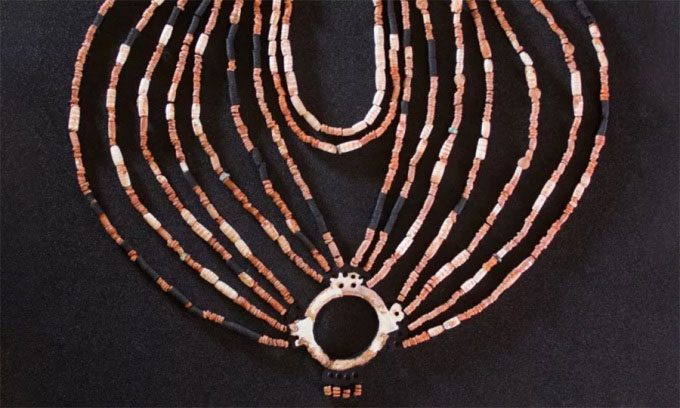The necklace, consisting of multiple strands made from over 2,500 stones and shell fragments, indicates that the child in the grave held a high social status.
European researchers have recreated the intricate necklace buried with an 8-year-old child in a grave at Ba’ja village, Jordan, dating back to approximately 7400 – 6800 BCE, during the Neolithic period. The Neolithic period is an archaeological era that began in the Middle East as early as the 10th millennium BCE. The reconstruction process is detailed in a newly published study in the journal PLOS One on August 2.

The physical recreation of the 9,000-year-old necklace displayed at the Petra Museum, Jordan. (Photo: Alarashi/PLOS One).
Ba’ja is one of the most important and thoroughly studied villages in the Southern Levant during the Neolithic period. Since 1997, archaeological research at Ba’ja has revealed significant, deep, and complex structures.
The grave was discovered in 2018, containing the skeletal remains of a child in a fetal position, along with over 2,500 colorful stones and shell fragments on the chest and neck, a stone pendant with a hole, and an intricately carved mother-of-pearl ring.
Through analysis of the materials, crafting methods, and distribution of the artifacts, the research team concluded that they belonged to a necklace made up of multiple strands. “Through various pieces of evidence, we believe that the necklace was crafted in Ba’ja, although significant components made from shells and stones originated from elsewhere, including fossilized amber,” the research team stated.
According to the research team, the necklace suggests that the owner of the grave held a significant social status. “The adornment with a large number of beads—over 2,500—is unprecedented in Neolithic villages of the Levant,” the team noted.
The research team reconstructed a physical version of the original necklace, which is now on display at the Petra Museum in Jordan. Since the parts of the necklace were not found in their original positions at the time of discovery, the reconstruction relied heavily on in-depth analysis and a series of estimates based on logical predictions.
“The reconstruction results exceeded our expectations, revealing an impressive multi-strand necklace with a complex structure and eye-catching design,” the research team shared. This is one of the most ancient and impressive examples of Neolithic adornment, shedding light on burial practices for those of high social status.
Experts note that the newly discovered necklace does not resemble any known Neolithic decorative traditions of the Levant to date. Its large size, complex structure, symmetry, harmony, and the beauty of the objects and colors evoke the intricate adornments of later Egyptian and Mesopotamian societies.
The crafting of the necklace required skilled workmanship and the importation of some exotic materials from other regions. This highlights the high level of connectivity between the ancient people of Ba’ja and the broader world.


















































